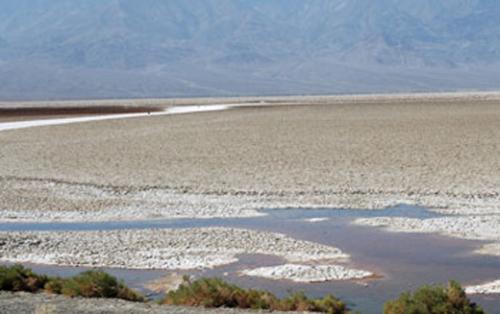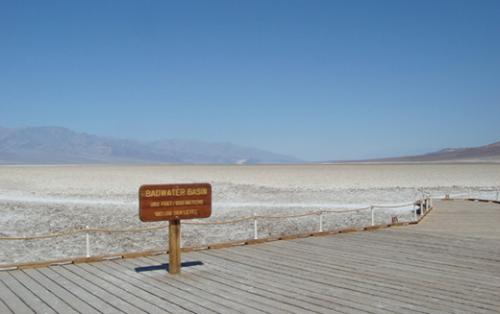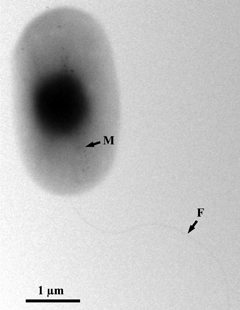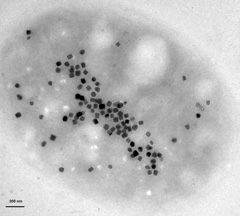Navigation
Badwater Basin: Death Valley Microbe Thrives There: Discovery may lead to novel biotech and nanotech uses
Scientists Dennis Bazylinski and colleagues at the University of Nevada Las Vegas (UNLV) sluice through every water body they can find in Nevada looking for new forms of microbial magnetism.
 Badwater Basin, lowest elevation in the Western He: Photograph by Dennis Bazylinski and Christopher Lefèvre
Badwater Basin, lowest elevation in the Western He: Photograph by Dennis Bazylinski and Christopher Lefèvre
Nevada, the "Silver State," is well-known for mining precious metals.
But scientists Dennis Bazylinski and colleagues at the University of Nevada Las Vegas (UNLV) do a different type of mining.
They sluice through every water body they can find, looking for new forms of microbial magnetism.
 Spring at Badwater Basin, Death VAlley National Park, where BW-1 was found.: Photograph by Dennis Bazylinski and Christopher Lefevre.In a basin named Badwater on the edge of Death Valley National Park, Bazylinski and researcher Christopher Lefèvre hit pay dirt.
Spring at Badwater Basin, Death VAlley National Park, where BW-1 was found.: Photograph by Dennis Bazylinski and Christopher Lefevre.In a basin named Badwater on the edge of Death Valley National Park, Bazylinski and researcher Christopher Lefèvre hit pay dirt.
Lefèvre is with the French National Center of Scientific Research and University of Aix-Marseille II.
In this week's issue of the journal Science, Bazylinski, Lefèvre and others report that they identified, isolated and grew a new type of magnetic bacteria that could lead to novel biotech and nanotech uses.
 A cell of the magnetotactic bacterium BW-1; it may fuel biotech and nanotech discoveries: Photograph by Dennis Bazylinski and Christopher LefèvreMagnetotactic bacteria are simple, single-celled organisms that are found in almost all bodies of water.
A cell of the magnetotactic bacterium BW-1; it may fuel biotech and nanotech discoveries: Photograph by Dennis Bazylinski and Christopher LefèvreMagnetotactic bacteria are simple, single-celled organisms that are found in almost all bodies of water.
As their name suggests, they orient and navigate along magnetic fields like miniature swimming compass needles.
This is due to the nano-sized crystals of the minerals magnetite or greigite they produce.
The presence of these magnetic crystals makes the bacteria and their internal crystals--called magnetosomes--useful in drug delivery and medical imaging.
The research was funded by the U.S. National Science Foundation (NSF), the U.S. Department of Energy and the French Foundation for Medical Research.
"The finding is significant in showing that this bacterium has specific genes to synthesize magnetite and greigite, and that the proportion of these magnetosomes varies with the chemistry of the environment," said Enriqueta Barrera, program director in NSF's Division of Earth Sciences.
While many magnetite-producing bacteria can be grown and easily studied, Bazylinski and his team were the first to cultivate a greigite-producing species. Greigite is an iron sulfide mineral, the equivalent of the iron oxide magnetite.
"Because greigite-producing bacteria have never been isolated, the crystals haven't been tested for the types of biomedical and other applications that currently use magnetite," said Bazylinski.
 Greigite-containing magnetotactic bacterium from Badwater Basin, Death Valley: Photograph by Dennis Bazylinski and Christopher Lefèvre"Greigite is an iron sulfide that may be superior to magnetite in some applications due to its slightly different physical and magnetic properties. Now we have the opportunity to find out."
Greigite-containing magnetotactic bacterium from Badwater Basin, Death Valley: Photograph by Dennis Bazylinski and Christopher Lefèvre"Greigite is an iron sulfide that may be superior to magnetite in some applications due to its slightly different physical and magnetic properties. Now we have the opportunity to find out."
Researchers found the greigite-producing bacterium, called BW-1, in water samples collected more than 280 feet below sea level in Badwater Basin. Lefèvre and Bazylinski later isolated and grew it leading to the discovery that BW-1 produces both greigite and magnetite.
A detailed look at its DNA revealed that BW-1 has two sets of magnetosome genes, unlike other such bacteria, which produce only one mineral and have only one set of magnetosome genes.
This suggests that the production of magnetite and greigite in BW-1 is likely controlled by separate sets of genes. That could be important in the mass production of either mineral for specific applications.
According to Bazylinski, the greigite-producing bacteria represent a new, previously unrecognized group of sulfate-reducing bacteria that "breathe" the compound sulfate rather than oxygen as most living organisms do.
"With how much is known about sulfate-reducing bacteria, it's surprising that no one has described this group," he said.
BW-1 cells swimming with the magnetic field.
Working with Bazylinski and Lefèvre on the project are David Pignol of the French National Center of Scientific Research and University of Aix-Marseille II; Nicolas Menguy of Pierre and Marie Curie University, France; Fernanda Abreu and Ulysses Lins of the Federal University of Rio de Janeiro, Brazil; Mihaly Pósfai of the University of Pannonia, Hungary; Tanya Prozorov of Ames Laboratory, Iowa; and Richard Frankel of California Polytechnic State University, San Luis Obispo.
A video is available at http://www.nsf.gov/news/news_images.jsp?cntn_id=122618&org=NSF
This article is from the National Science Foundation (NSF), 23 December 2011.
Search
Latest articles
Agriculture
- World Water Week: Healthy ecosystems essential to human health: from coronavirus to malnutrition Online session Wednesday 24 August 17:00-18:20
- World Water Week: Healthy ecosystems essential to human health: from coronavirus to malnutrition Online session Wednesday 24 August 17:00-18:20
Air Pollution
- "Water and Sanitation-Related Diseases and the Changing Environment: Challenges, Interventions, and Preventive Measures" Volume 2 Is Now Available
- Global Innovation Exchange Co-Created by Horizon International, USAID, Bill and Melinda Gates Foundation and Others
Biodiversity
- It is time for international mobilization against climate change
- World Water Week: Healthy ecosystems essential to human health: from coronavirus to malnutrition Online session Wednesday 24 August 17:00-18:20
Desertification
- World Water Week: Healthy ecosystems essential to human health: from coronavirus to malnutrition Online session Wednesday 24 August 17:00-18:20
- UN Food Systems Summit Receives Over 1,200 Ideas to Help Meet Sustainable Development Goals
Endangered Species
- Mangrove Action Project Collaborates to Restore and Preserve Mangrove Ecosystems
- Coral Research in Palau offers a “Glimmer of Hope”
Energy
- Global Innovation Exchange Co-Created by Horizon International, USAID, Bill and Melinda Gates Foundation and Others
- Wildlife Preservation in Southeast Nova Scotia
Exhibits
- Global Innovation Exchange Co-Created by Horizon International, USAID, Bill and Melinda Gates Foundation and Others
- Coral Reefs
Forests
- NASA Satellites Reveal Major Shifts in Global Freshwater Updated June 2020
- Global Innovation Exchange Co-Created by Horizon International, USAID, Bill and Melinda Gates Foundation and Others
Global Climate Change
- It is time for international mobilization against climate change
- It is time for international mobilization against climate change
Global Health
- World Water Week: Healthy ecosystems essential to human health: from coronavirus to malnutrition Online session Wednesday 24 August 17:00-18:20
- More than 400 schoolgirls, family and teachers rescued from Afghanistan by small coalition
Industry
- "Water and Sanitation-Related Diseases and the Changing Environment: Challenges, Interventions, and Preventive Measures" Volume 2 Is Now Available
- Global Innovation Exchange Co-Created by Horizon International, USAID, Bill and Melinda Gates Foundation and Others
Natural Disaster Relief
- STOP ATTACKS ON HEALTH CARE IN UKRAINE
- Global Innovation Exchange Co-Created by Horizon International, USAID, Bill and Melinda Gates Foundation and Others
News and Special Reports
- World Water Week: Healthy ecosystems essential to human health: from coronavirus to malnutrition Online session Wednesday 24 August 17:00-18:20
- STOP ATTACKS ON HEALTH CARE IN UKRAINE
Oceans, Coral Reefs
- World Water Week: Healthy ecosystems essential to human health: from coronavirus to malnutrition Online session Wednesday 24 August 17:00-18:20
- Mangrove Action Project Collaborates to Restore and Preserve Mangrove Ecosystems
Pollution
- Zakaria Ouedraogo of Burkina Faso Produces Film “Nzoue Fiyen: Water Not Drinkable”
- "Water and Sanitation-Related Diseases and the Changing Environment: Challenges, Interventions, and Preventive Measures" Volume 2 Is Now Available
Population
- "Water and Sanitation-Related Diseases and the Changing Environment: Challenges, Interventions, and Preventive Measures" Volume 2 Is Now Available
- "Water and Sanitation-Related Diseases and the Changing Environment: Challenges, Interventions, and Preventive Measures" Volume 2 Is Now Available
Public Health
- Honouring the visionary behind India’s sanitation revolution
- Honouring the visionary behind India’s sanitation revolution
Rivers
- World Water Week: Healthy ecosystems essential to human health: from coronavirus to malnutrition Online session Wednesday 24 August 17:00-18:20
- Mangrove Action Project Collaborates to Restore and Preserve Mangrove Ecosystems
Sanitation
- Honouring the visionary behind India’s sanitation revolution
- Honouring the visionary behind India’s sanitation revolution
Toxic Chemicals
- "Water and Sanitation-Related Diseases and the Changing Environment: Challenges, Interventions, and Preventive Measures" Volume 2 Is Now Available
- Actions to Prevent Polluted Drinking Water in the United States
Transportation
- "Water and Sanitation-Related Diseases and the Changing Environment: Challenges, Interventions, and Preventive Measures" Volume 2 Is Now Available
- Urbanization Provides Opportunities for Transition to a Green Economy, Says New Report
Waste Management
- Honouring the visionary behind India’s sanitation revolution
- Honouring the visionary behind India’s sanitation revolution
Water
- Honouring the visionary behind India’s sanitation revolution
- Honouring the visionary behind India’s sanitation revolution
Water and Sanitation
- Honouring the visionary behind India’s sanitation revolution
- Honouring the visionary behind India’s sanitation revolution

